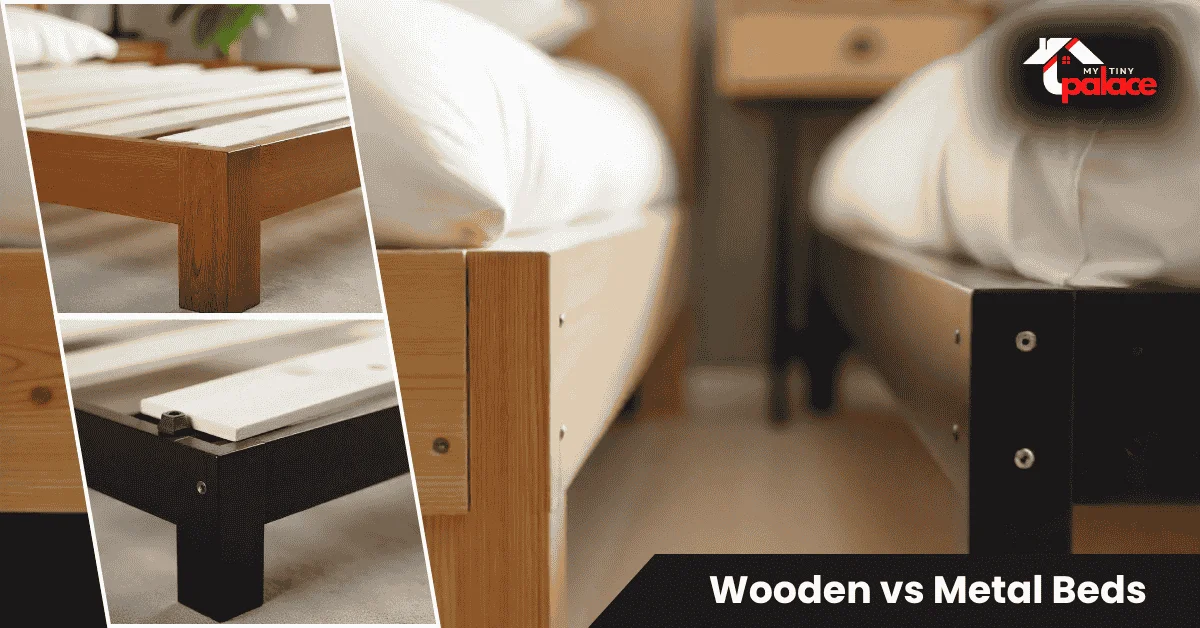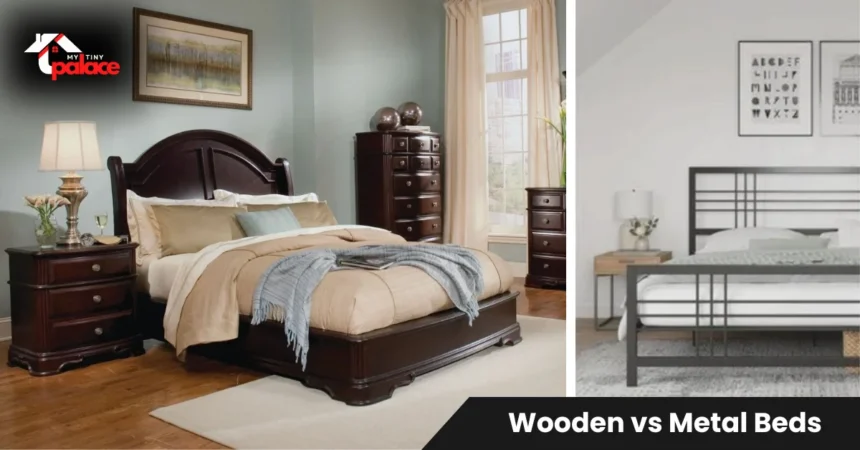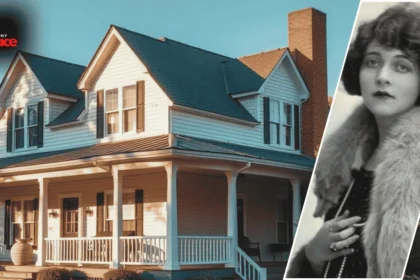Choosing between a wooden bed frame and a metal one comes down to your lifestyle. Wooden beds offer classic warmth and long-term durability but weigh more and cost more upfront. Metal frames are lightweight, budget-friendly, and easy to move, though they can squeak over time. This guide compares strength, style, cost, and maintenance so you can pick the right bed frame for your space, budget, and how often you move.
- Wooden vs Metal Beds: Which is Better?
- Types of frames and materials
- Why this choice matters — comfort, budget, and lifestyle
- How to choose the right bed frame for you
- Durability, maintenance, and noise
- Assembly, moving, and installation tips
- Costs, lifespan, and a compact comparison table
- Pros & cons — who should consider wood or metal
- Quick summary + CTA (what to do next)
Wooden vs Metal Beds: Which is Better?
Wooden bed frames include solid hardwood (oak, maple, walnut) and engineered wood options like plywood or MDF with veneer finishes. Metal frames come in steel tubular designs, wrought iron beds, and powder-coated platform styles. The decision hinges on five factors: durability, style, cost, noise levels, and how portable you need the frame to be.
Your best choice depends on your priorities. If you value timeless aesthetics and plan to stay put for years, wood wins. If you move often or want a modern look on a tight budget, metal makes more sense. Neither is universally better — they excel in different situations.
Types of frames and materials
Solid hardwood frames use oak, maple, cherry, or walnut. They’re heavy, strong, and handle weight without flexing. Engineered wood frames use plywood or particleboard with veneer or laminate surfaces. They cost less but may not last as long under heavy use.
Metal frames typically use steel tubing or wrought iron. Steel frames are lightweight and often powder-coated to resist rust. Iron beds are heavier and more decorative but prone to chipping if the finish wears.
Most frames come in three styles: platform beds with built-in slats, slatted bases that need a box spring, and adjustable frames compatible with any mattress type. Platform beds work great with memory foam or latex mattresses. Slatted wood bases offer slight flex, which some sleepers prefer. Metal platforms are firmer and better for heavier mattresses.
Why this choice matters — comfort, budget, and lifestyle
Your bed frame affects daily comfort. A sturdy frame keeps your mattress from sagging and prevents squeaks that disrupt sleep. It also impacts your budget — cheap frames need replacing sooner, costing more over time. Your lifestyle matters too. If you move every year or two, a heavy solid wood frame becomes a hassle.
Consider two scenarios. A renter who moves cities for work needs a lightweight metal frame that disassembles quickly and fits tight staircases. A homeowner decorating a master bedroom for the next decade benefits from a solid wood frame that matches built-in furniture and stays squeak-free.
Think about your space too. Metal frames often have thinner profiles, leaving more floor space visible in small bedrooms. Wooden frames with thick posts and headboards create a statement piece but take up more visual and physical room.
How to choose the right bed frame for you
Ask yourself these questions. How often do you move? What’s your budget for upfront cost and maintenance? Do you want the bed to be a visual focal point or blend in? Do you need under-bed storage space? Does anyone in your household have mobility issues that require specific bed heights?
Here’s a simple rule: if you move more than once every three years or rent short-term, go metal. If you own your home and prioritize aesthetics, choose wood. If budget is tight, metal wins on price.
Renters and students: Pick a metal frame. They’re lightweight, easy to disassemble, and won’t scratch floors or walls during moves. Look for tubular steel with a powder-coated finish.
Style-first homeowners: Choose solid hardwood. Oak or walnut frames age beautifully and match most decor. They feel substantial and won’t wobble after years of use.
Budget buyers: Metal frames cost half as much upfront. If you’re furnishing your first apartment or guest room, a basic steel platform frame does the job without breaking the bank.
Durability, maintenance, and noise

Solid wood frames last twenty to thirty years if maintained. Joints can loosen over time, causing squeaks. Tighten bolts and screws twice a year using a hex key or socket wrench. Scratches happen — touch them up with furniture markers or wood stain pens.
Metal frames last ten to twenty years. Steel resists rust when powder-coated, but scratches expose bare metal that oxidizes. Wipe frames monthly with a damp cloth to prevent buildup. Squeaks come from metal-on-metal contact at joints. Apply silicone lubricant to bolts and add rubber washers between connecting parts.
Both materials need regular maintenance. Check all fasteners quarterly. If slats bow or crack, replace them immediately to protect your mattress. For wood, reapply finish or wax every few years to keep surfaces smooth. For metal, touch up chipped paint with rust-resistant spray paint.
Noise is the biggest complaint about metal beds. Every movement transfers through the frame. Prevent squeaks by tightening bolts, adding washers, and placing felt pads under metal-on-metal contact points. Wooden beds creak less but aren’t silent — joints shift over time as wood expands and contracts with humidity.
Assembly, moving, and installation tips
Most bed frames arrive flat-packed with instructions. Wooden frames take longer to assemble because they’re heavier and have more parts. Metal frames snap together quickly — some assemble in under thirty minutes.
Moving a wooden bed requires planning. Disassemble completely and wrap each piece in moving blankets. Recruit help for lifting — a solid queen headboard can weigh sixty to eighty pounds. Metal frames are lighter and easier to maneuver through doorways and stairs.
Always anchor tall or bunk beds to the wall using L-brackets and wall anchors rated for your wall type (drywall, plaster, or studs). This prevents tipping, especially if kids climb on the frame. Follow manufacturer weight limits strictly — overloading causes joint failure.
Tools you’ll need
Keep a hex key set, adjustable wrench, rubber mallet, tape measure, and level on hand. Some metal frames need a Phillips screwdriver. For wooden frames, add wood glue for reinforcing loose joints.
Quick 5-step assembly & move checklist
- Lay out all parts and hardware before starting — count bolts and confirm nothing’s missing.
- Assemble the headboard and footboard first, then attach side rails.
- Add center support beam for queen or king sizes — it prevents sagging.
- Install slats evenly and confirm they’re secure before adding the mattress.
- When moving, label each piece with masking tape so reassembly goes faster.
Costs, lifespan, and a compact comparison table
Wooden frames cost more upfront but spread that cost over decades. Metal frames are cheaper initially but may need replacement sooner. Here’s a realistic breakdown:
| Feature | Wooden Frame | Metal Frame |
|---|---|---|
| Upfront Cost | $300–$1,500 | $100–$600 |
| Expected Lifespan | 20–30 years | 10–20 years |
| Ease of Moving | Heavy, requires help | Light, one-person move |
Cost-per-year tells the real story. A $900 wooden frame over twenty-five years costs $36 annually. A $250 metal frame over twelve years costs about $21 annually. Metal is cheaper if you move often and replace frames after each relocation. Wood is cheaper if you keep it for decades.
Pros & cons — who should consider wood or metal
Wooden frames offer timeless style, solid construction, and minimal squeaking. They handle heavy mattresses well and feel stable. Drawbacks include higher cost, more weight, and potential for scratches or finish wear. They’re harder to move and can be difficult to fit through narrow staircases.
Metal frames are affordable, lightweight, and come in modern or industrial styles. They’re easy to assemble and perfect for frequent movers. Downsides include noise from loose bolts, rust risk in humid climates, and less visual warmth.
Choose wood if you own your home, want a statement piece, and plan to keep the bed for years. Choose metal if you’re renting, move often, or need a budget-friendly guest bed. Consider a hybrid — metal base with a wooden headboard — for style without the weight.
Quick summary + CTA (what to do next)
Pick the frame that fits your life, not just your room’s style. Measure your bedroom space, check your mattress type for compatibility, and confirm the frame’s weight capacity matches your needs. Compare two frames in your price range this week — one wood, one metal — and imagine moving them up your stairs. That test will make your decision clear.














